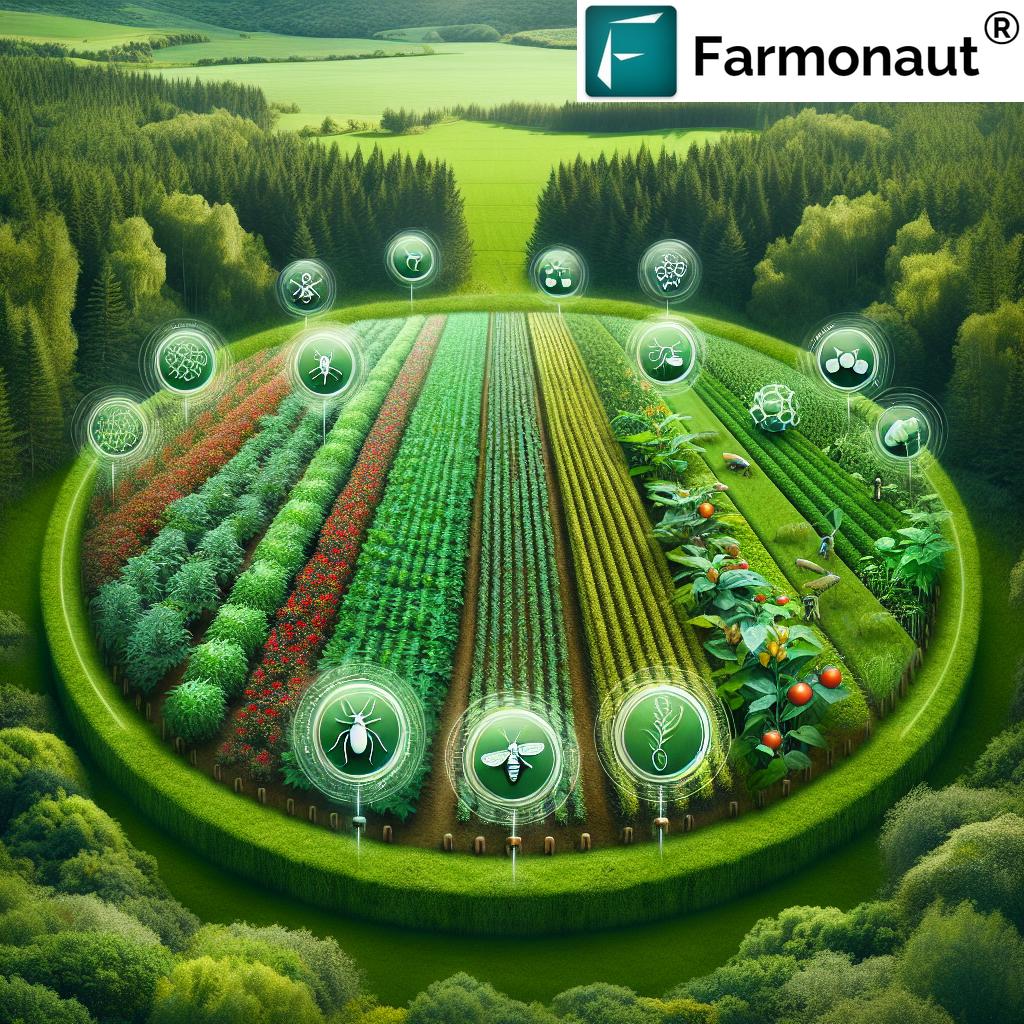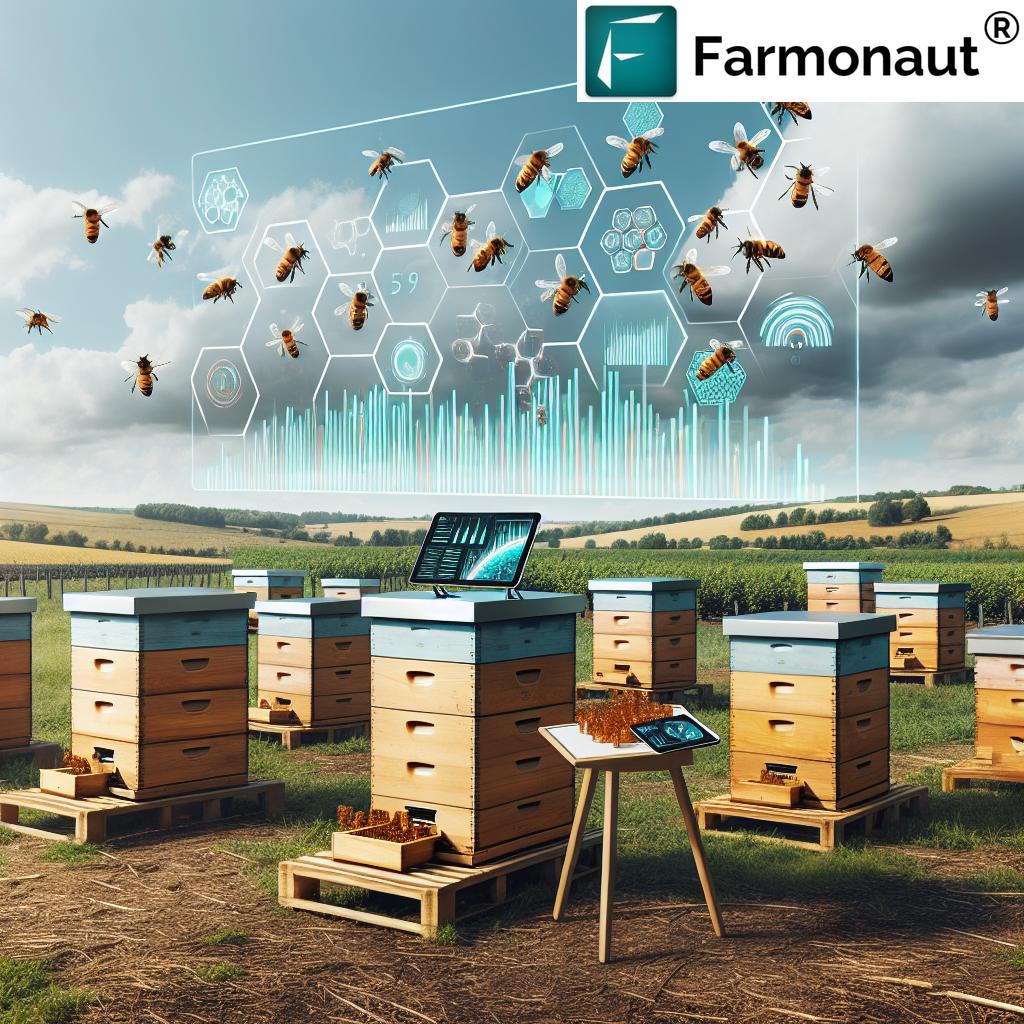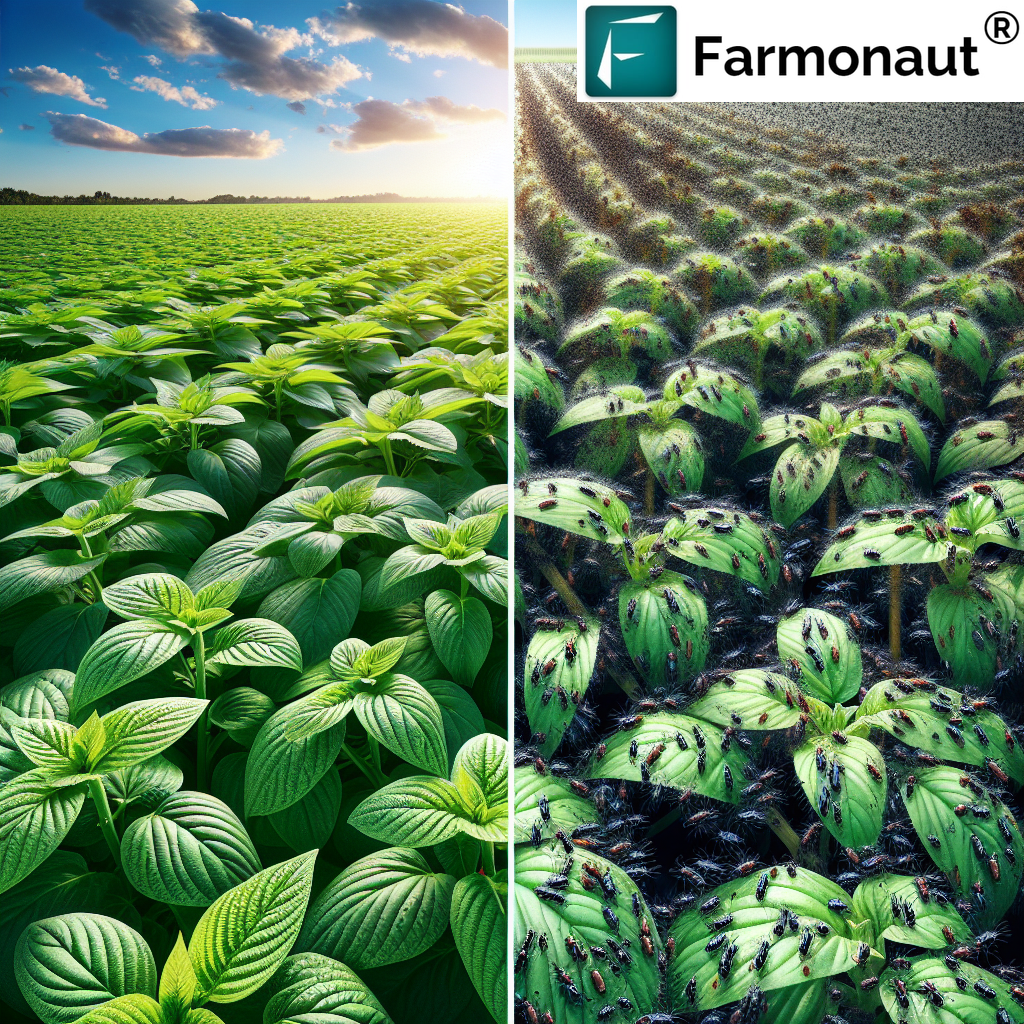Pest Control Specialists Reveal 7 Shocking Farm Hacks
“Over 70% of pest control specialists now use integrated pest management to reduce chemical pesticide use in agriculture.”
- Introduction: Why Sustainable Pest Control Matters
- Understanding Pest Control in Agriculture and Forestry
- Integrated Pest Management (IPM): A Holistic Approach
- The Role of Pest Control Specialists in Sustainable Agriculture
- Technological Advancements in Pest Monitoring and Management
- Farmonaut: Elevating Agricultural Pest Management with Precision Tech
- Pest Control Specialists Reveal 7 Shocking Farm Hacks
- Comparative Table: 7 Farm Hacks by Pest Control Specialists
- Regulatory Framework: Ensuring Safe, Responsible Pest Management
- Challenges, Solutions, and The Future of Pest Control
- FAQ About Pest Control in Agriculture and Forestry
- Conclusion: Building a Resilient & Sustainable Agricultural Future
“Sustainable pest control practices can decrease pesticide runoff by up to 50%, protecting nearby forests and water sources.”
Introduction: Why Sustainable Pest Control Matters
Pest control is an indispensable pillar of agriculture and forestry, directly impacting food security, environmental protection, and sustainable land management. As pest control specialists, we understand that managing pests goes far beyond spraying chemicals—our work is about achieving ecological balance while safeguarding farm productivity and forest biodiversity. Through a mix of integrated pest management (IPM), advanced technologies, and sustainable practices, we are evolving how farms and forests overcome pest threats.
In this comprehensive guide, we’ll unravel how pest control specialists are transforming agricultural and forestry pest management. We’ll reveal 7 shocking (but surprisingly effective!) farm hacks, delve into advanced pest monitoring technologies, and highlight the true environmental and economic importance of our craft.
Understanding Pest Control in Agriculture and Forestry
Pests—from insects and rodents to fungi and weeds—can inflict devastating damage on agricultural and forestry operations. The consequences include reduced yields, compromised product quality, and substantial production costs. Beyond farms, unmanaged pest populations threaten forests, leading to degradation, loss of biodiversity, and declining ecosystem health.
The complexity of pest management compels us to develop strategies that efficiently mitigate risks, maintain productivity, and preserve the health of ecosystems across agriculture and forestry. No single solution suffices—modern pest control demands a nuanced, holistic approach.
Integrated Pest Management (IPM): A Holistic Approach
Today’s pest control specialists prioritize Integrated Pest Management (IPM)—a comprehensive strategy that combines multiple methods to achieve sustainable, long-term pest control solutions. Unlike conventional one-size-fits-all chemical treatments, IPM seeks to minimize environmental impact and enhance ecosystem health.
- Prevention over remediation: By focusing on preventing infestations (with resistant plant varieties and well-timed planting), we avoid large-scale damage before it begins.
- Detailed pest monitoring: Through regular assessment and monitoring of crops and forests, we target controls only when necessary, reducing chemical inputs.
- Combination of methods: We integrate biological, cultural, mechanical, and (where strictly required) chemical controls, tailoring strategies to each field or forest’s unique conditions.
- Adaptability: IPM is a living process—constantly evolving as pest pressures, climate, and regulations change.
This integrated approach benefits farmers, landowners, and the environment, ensuring long-term sustainability and reducing reliance on potentially harmful pesticides.
The Role of Pest Control Specialists in Sustainable Agriculture
Pest control specialists—also referred to as pest control advisors (PCAs)—bring invaluable expertise to agricultural and forestry pest management. Our responsibilities span the full spectrum of pest management activities and are crucial for safeguarding crops, forests, and livestock.
Key Roles and Responsibilities of Pest Control Specialists
- Monitoring and Assessment: We regularly inspect crops and forests for early signs of pest infestations, using both hands-on fieldwork and technology (see next section).
- Developing Management Plans: We craft customized pest management plans—choosing the safest, most effective control methods based on each operation’s ecosystem, economic considerations, and crop or forest type.
- Implementing Control Measures: We apply biological controls (using natural predators), physical/mechanical controls (like traps and barriers), and, only when necessary, targeted chemical controls that minimize non-target effects.
- Education and Training: We empower farmers, landowners, and forestry professionals to adopt proven sustainable pest control practices.
- Regulatory Compliance: We ensure strict adherence to all regulations around pesticide application, environmental standards, and record-keeping.
This multi-faceted approach enables pest control specialists to balance productivity, sustainability, and responsible use of resources.
Technological Advancements in Pest Monitoring and Management
Emerging technologies are revolutionizing the monitoring, assessment, and control of pests in agriculture and forestry—enabling smarter, data-driven interventions that reduce risks and optimize resource use. We, as pest control professionals, increasingly leverage:
Satellite and Sensor-Based Technologies
- Satellite imagery: Enables large-scale pest monitoring, detecting crop health anomalies that could signal pest infestation.
- Sensor technology: In-field sensors gather soil moisture, temperature, and weather data, allowing us to forecast pest development patterns and intervene with precision.
The Rise of Drones and Aerial Assessment
- Drones: Provide rapid aerial surveillance of vast farming areas. We use them to spot infestation hotspots, monitor crop health in real time, and even deliver targeted pesticide applications—minimizing environmental impact and chemical use.
Artificial Intelligence and Advanced Analytics
- AI-powered advisory: By analyzing pest monitoring data and weather trends, AI systems provide tailored crop protection strategies.
- Blockchain-based traceability: Increases transparency and security for agricultural supply chains, ensuring integrity in the use of pesticides and sustainable practices.
The result is greater precision, optimized pest management decisions, and a reduction in overall chemical applications—a win for the environment and productivity alike.
Farmonaut: Elevating Agricultural Pest Management with Precision Tech
Farmonaut is ushering in a new era in agriculture by making advanced, satellite-powered farm management tools accessible to all farmers and agribusinesses. Our full-featured platform is designed for seamless adoption from smallholders to large landowners. Here’s how Farmonaut is redefining pest control:
-
Real-time Satellite Crop Health Monitoring:
Farmonaut enables precise crop health assessment using multispectral imagery (like NDVI), allowing for early detection of pest damage and disease stress across large areas.
Explore Farmonaut’s Large Scale Farm Management Platform
—Ideal for agribusinesses and government agencies needing comprehensive crop monitoring tools. -
AI-Driven Jeevn Advisory System:
Farmonaut’s Jeevn AI offers personalized, real-time farm advisory—from weather forecasts to expert crop protection strategies. This empowers better, faster, and more informed decisions for pest and disease management. -
Blockchain-based Traceability:
By leveraging blockchain, Farmonaut ensures product origin and journey are transparent, which is vital for regulatory compliance with pesticide application and food safety.
Learn how Farmonaut Traceability can boost transparency and trust in your supply chain!
-
Resource and Fleet Management:
The platform’s tools help farmers and agribusinesses reduce operational costs and improve efficiency, ensuring timely interventions for sustainable pest control practices.
Discover Fleet Management Solutions for Large Farms
-
Environmental & Carbon Footprint Tracking:
Farmonaut’s platform tracks carbon emissions and resource use, enabling more sustainable agriculture.
Explore Farmonaut Carbon Footprinting Tools for Sustainability Leadership
-
Support for Crop Loans and Insurance:
Satellite-based verification streamlines crop insurance and financing—reducing fraud and supporting farmers in managing pest risks.
Learn About Satellite-Based Crop Loan & Insurance Verification
Our platform is accessible on Android, iOS, and web. Try the Farmonaut app:
API access: For custom integrations and advanced pest monitoring technologies, developers can tap into the Farmonaut API platform. Read our API developer docs.
Pest Control Specialists Reveal 7 Shocking Farm Hacks
Through years of experience, pest control specialists have identified remarkably effective farm hacks at the intersection of technology, traditional wisdom, and ecological awareness. Let’s explore the top 7 hacks that are transforming agricultural pest management and forestry pest control:
-
Adopt Resistance-Boosting Crop Varieties
Selecting and planting pest-resistant crop varieties and forest trees disrupts pest life cycles and reduces vulnerability to outbreaks. This hack forms the bedrock of robust integrated pest management.
- Drastically lowers need for chemical pesticides
- Reduces pest development and infestations naturally
- Protects yields and improves overall crop health
-
Deploy Biological Pest Control Methods Using Natural Predators
Releasing or attracting natural predators (e.g., ladybugs, lacewings, or parasitoid wasps) into agricultural fields and forests significantly suppresses insect pest populations.
- Targets pests without harming beneficial species or the environment
- Reduces reliance on chemical controls
- A key element of sustainable biological pest control
-
Utilize Crop Rotation and Intercropping for Natural Barrier Creation
Implementing diverse cropping patterns (crop rotation and intercropping) confuses pests, disrupts their breeding cycles, and suppresses weeds and fungi.
- Improves soil health alongside pest control
- Reduces overall pest pressure naturally
- Enhances resilience of farm ecosystems
-
Leverage Precision Technologies (e.g., Drones and Sensors)
Use smart drones, satellite monitoring, and sensor technologies (such as those provided by Farmonaut) to spot pest infestations early and target interventions only where needed.
- Prevents large-scale outbreaks through rapid, targeted response
- Reduces chemical pesticide application volume and environmental impact
- Boosts productivity and profitability through efficient resource use
-
Apply Physical and Mechanical Barriers
Harness physical controls such as mulching, row covers, netting, sticky traps and barriers—creating a defensive shield for crops against rodents, insects, and weeds.
- Non-chemical approach with minimal environmental impact
- Ideal as part of an integrated pest management plan
-
Implement Targeted, Reduced-Risk Pesticides Only When Necessary
When chemical intervention cannot be avoided, use reduced-risk pesticides that are less toxic to non-target organisms and break down more rapidly in the environment.
- Protects local biodiversity and water sources
- Helps prevent pesticide resistance in pest populations
-
Enhance Habitat for Beneficial Fauna
Foster on-farm biodiversity by planting hedgerows, wildflower strips, or buffer zones. This provides a home for natural predators that keep pests in check and enhances ecosystem balance.
- Promotes long-term reduction in pest incidents
- Contributes to ecological sustainability and resilience
Comparative Table: 7 Farm Hacks by Pest Control Specialists
| Hack Description | Pest Control Method Used | Estimated Effectiveness (% Reduction in Pest Incidents) | Environmental Impact | Sustainability Score (1-5) | Implementation Cost |
|---|---|---|---|---|---|
| Resistance-Boosting Crop Varieties | Cultural/Preventive | 50–70% | Low | 5 | Medium |
| Biological Control Using Natural Predators | Biological | 40–60% | Low | 5 | Low–Medium |
| Crop Rotation & Intercropping | Cultural | 30–50% | Low | 5 | Low |
| Precision Tech: Drones & Sensors | Technological/Physical | 60–80% (with timely intervention) | Low–Medium | 4 | Medium–High |
| Physical/Mechanical Barriers (traps, etc.) | Physical/Mechanical | 30–50% | Low | 4 | Low–Medium |
| Targeted Reduced-Risk Pesticides | Chemical (Targeted) | 40–60% | Medium | 3 | Medium |
| Enhancing Habitat for Beneficial Fauna | Ecological/Biological | 20–40% (long-term) | Low | 5 | Low |
Regulatory Framework: Ensuring Safe, Responsible Pest Management
Pest control activities—from pesticide application to advisory—are strictly regulated. In regions like Louisiana (U.S.), specialized licenses are required to ensure only trained professionals implement pest management strategies. Key licensing includes:
- Commercial Pesticide Certification: For those applying pesticides on farms or by aircraft, confirming expertise and responsibility.
- Structural Pest Control License: Required where pest control extends to farm buildings or structures.
- Agricultural Consultant License: Allows for reliable, paid pest management recommendations.
These regulations are in place to protect human health, maintain environmental standards, and preserve ecosystem integrity during all pest management activities.
Challenges, Solutions, and The Future of Pest Control
Even the most advanced pest control specialists confront persistent and emerging challenges, including:
- Pesticide resistance: Overuse or misuse of chemicals can foster resistant pest populations that become harder to eradicate.
- Emerging pest species: Shifts in climate and trade can introduce new, highly adaptive pests previously unseen in local ecosystems.
- Balancing effectiveness with environmental protection: Ensuring robust crop protection while minimizing environmental impact remains paramount.
The future of sustainable pest control lies in:
- Wider adoption of advanced technologies—AI, ML, drones, and satellite-based monitoring as pioneered by solutions like Farmonaut.
- Ongoing research into biorational (biologically-based, low-toxicity) pesticides.
- Collaboration among farmers, landowners, specialists, and regulators to co-create practical, ecological, and economic pest management strategies.
Optimize Your Farm’s Pest Management with Farmonaut Subscriptions
For direct access to cutting-edge crop health monitoring, real-time advisories, and carbon footprint tools to support sustainable pest management, check our flexible, scalable subscription options:
FAQ About Pest Control in Agriculture and Forestry
In our experience, the most common agricultural pests include insects (like aphids, caterpillars, and beetles), rodents, weeds, and fungi. We control them through a mix of integrated pest management (IPM), biological pest control methods, mechanical traps, and, only as a last resort, targeted chemical pesticides.
What is the safest approach to pest control that also protects the environment?
The safest and most effective approach is IPM, which combines biological, cultural, and physical control methods with regular monitoring. Using technology, such as satellite- or sensor-based pest monitoring (like Farmonaut’s platform), can significantly lessen the need for chemical inputs.
How do advanced technologies make pest management more sustainable?
Technologies, including drones, sensors, and AI-driven advisory systems, enable early detection of infestations, targeted control applications, and better data for long-term planning—reducing the overall environmental impact of pesticides and improving farm sustainability.
How does Farmonaut help with integrated pest management?
Farmonaut provides real-time satellite data, AI-powered advisories, and resource tracking that together optimize pest interventions, reduce pesticide use, and boost agricultural productivity with less environmental risk.
Are physical and mechanical pest controls effective for all types of farms?
Yes, especially for small- and medium-sized operations. Traps, barriers, netting, and row covers can greatly reduce pest incidents with negligible environmental impact and limited financial investment.
Can sustainable pest control methods affect farm yields?
Properly managed, sustainable pest control practices not only protect but often enhance crop yields and quality by maintaining ecosystem health and preventing destructive pest outbreaks before they escalate.
Conclusion: Building a Resilient & Sustainable Agricultural Future
Pest control specialists are at the forefront of protecting agriculture, farming, and forestry from the adverse effects of pests. By embracing integrated pest management, leveraging emerging technologies (like those offered by Farmonaut), and upholding sustainable pest control practices, we are ensuring healthier crops, more resilient forests, and a cleaner environment. The work of pest control specialists transcends short-term fixes, aiming instead for ecological stability, food security, and prosperity for future generations.
Let us work together—farmers, landowners, regulators, and technology leaders—to strengthen the connections between innovation, tradition, and stewardship of our world’s most vital resources!
Ready to revolutionize your pest management approach? Download the Farmonaut app, access our web dashboard, or explore the Farmonaut API for developers and enterprise.











